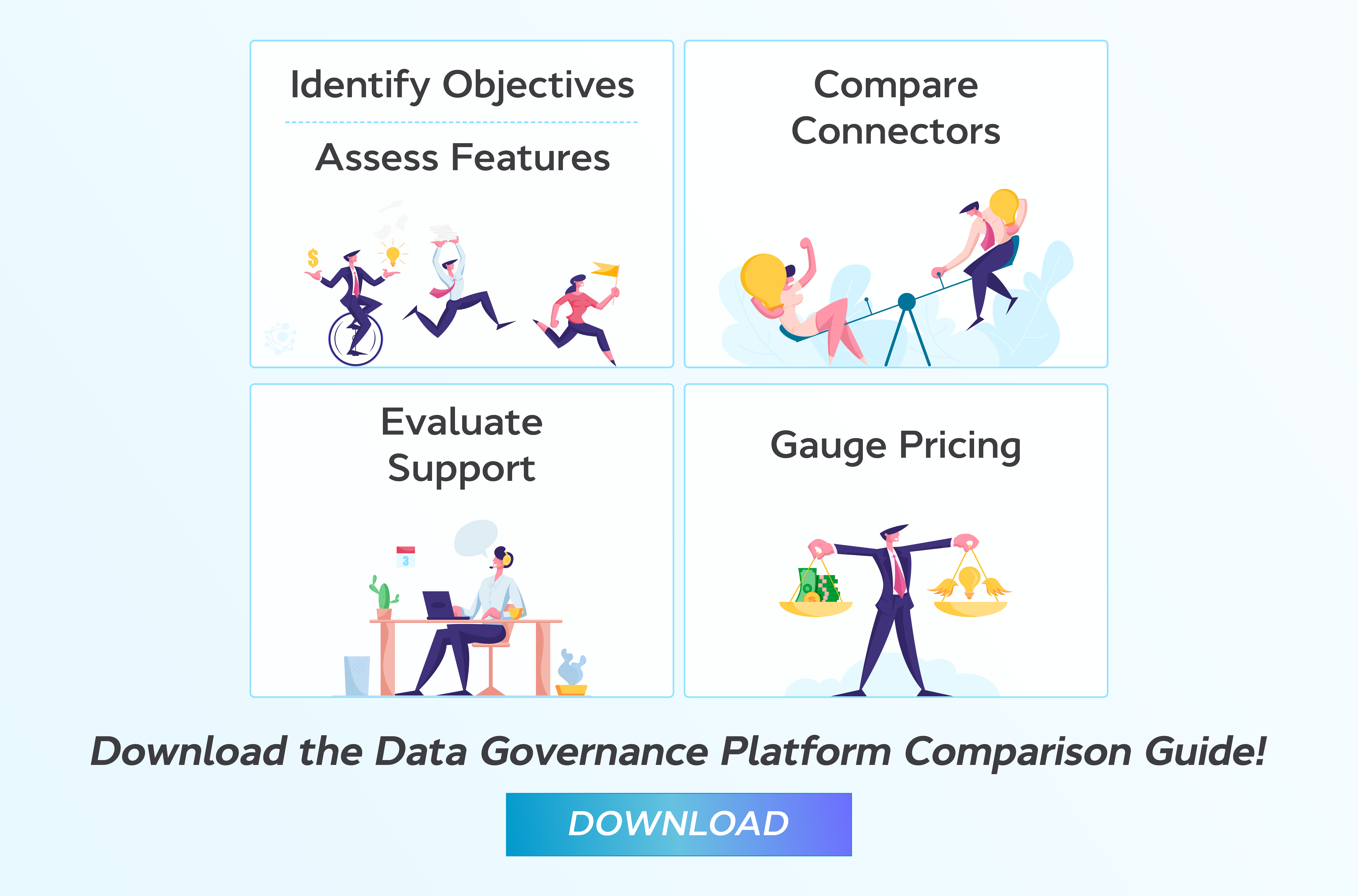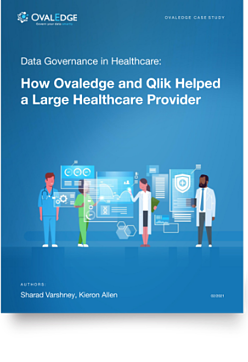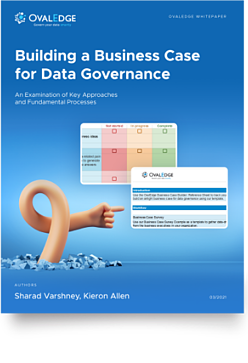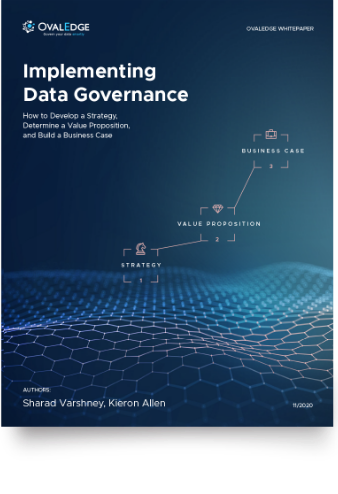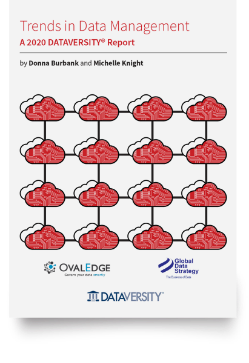Table of Contents
Assessing Data Governance Platforms
Learn how to assess data governance platforms in five steps utilizing the OvalEdge Data Governance Platform Comparison Guide.
How to Assess Data Governance Platforms?
Assessing data governance platforms is overwhelming; the market is saturated, and you have a budget. Selecting a data governance platform doesn’t have to be difficult, though. You just need a clear plan.
You’ve already surpassed one of the biggest challenges, deciding to obtain a data governance platform. The benefits of data governance are widespread, and the cost of inaction can severely impact an organization. So, your reasons for seeking a data governance platform are unique to your organization’s objectives.
Whether the goal is to curate an extensive data catalog for data discovery or increase data quality, the platform must fulfill your current and future needs while remaining cost-effective.
Most platform comparison guides assess features, but that’s like looking at individual trees instead of the entire forest. This blog will take you through the areas of assessing data governance platforms and what to look out for each step of the way. OvalEdge’s Data Governance Platform Comparison Guide considers objectives, features, connectors, support, and pricing to provide the most comprehensive comparison possible.
Step One: Identify Objectives
Prioritizing data governance drivers allows for focus while researching data governance applications. The most important objectives are the immediate requirements that must be met.
Keep in mind that objectives shift and grow over time. The tool should be able to grow with these evolving objectives. For example, if the main focus is cataloging data into a central repository, an eventual evolution of the main objective could be classifying data for better access controls to enhance data discovery and self-service.
The OvalEdge Data Governance Platform Comparison Guide outlines a wide range of objectives, such as:
- Data Catalog: Establish the data catalog for easy discoverability. Define curation best practices and self-service offerings.
- Business Glossary: Curate business glossary terms for consistent metadata. Collaborate with stakeholders to clarify terms’ definitions, policies, and compliances.
- Lineage: Track data from source to consumption. Understand the data’s journey to identify quality issues and the impact of upstream and downstream changes.
- Data Quality: Implement the four aspects of data quality—reactive, proactive, fit-for-consumption data quality, and anomaly detection—to ensure confidence in data-driven decisions.
- Data Classification: Find and classify data to establish masking and restricting policies based on safe handling practices.
- Centralized Data Access Control: Establish roles and permissions for data protection and data discovery.
- Privacy Compliance: Find PII and other sensitive data across the data ecosystem and implement access controls.
- Technical Debt Reduction: Identify and remove duplicate assets or those no longer in use.
The organization’s objectives can encapsulate more than one of these initiatives, so prioritizing them helps with platform assessment.
Step Two: Assess Features
Prioritizing objectives is a great place to start when looking for a data governance platform, but soon enough, the scope narrows down to the platform’s features. There’s more than one way to cook an egg; similarly, there is more than one way to accomplish any objective in a data governance tool.
Regardless of your main objective, seamlessness is a major consideration to keep at the forefront. How well do the features of the evaluated product work together across the entire application?
At this point in the evaluation process, you’re likely participating in demos of several products. Pay attention to how each platform’s features focus on furthering data governance initiatives as a whole.
Data governance gives insight into the data consumption layer and ensures data objects abide by the best sources, abbreviations, and metric calculations for a single source of truth. A comprehensive data catalog and data governance platform works to implement and manage the goals of data governance.
If a platform’s features fail to advance these goals comprehensively, there’s a chance that the platform added a data catalog to its product which may not be fully integrated.
Step Three: Compare Connectors
At the risk of sounding redundant, make sure the connectors you need are included during platform evaluation. There are two ways to look at the number of connectors from your source systems to the assessed platform: isolate the evaluation to the source systems you have or look at the entire number of connectors each platform supports.
Looking solely for your organization’s source systems helps narrow down platforms, especially if they do not support several connectors you need. In the case of missing connectors, each platform should be able to indicate how long it takes to build them. This step is more of an indicator of the platform’s scalability. Can the platform quickly scale to meet the organization’s minimum requirements?
Assessing the full scope of connectors provides insights into the range of source systems a platform has integrated into its product. What is the platform’s expertise for different types of connectors such as Relational Database Management Systems (RDBMS), reporting, and file systems?
Step Four: Evaluate Support
Including support in the evaluation indicates how seriously a platform prioritizes your success after installation.
Here are questions to help evaluate a platform’s support, separated into three areas:
- General support: How do you report bugs or seek other professional services?
- Documentation and training: How extensive is the product documentation? Is any learning provided in a structured setting (workshops) or through self-paced material (online academy)?
- Future enhancements: Do you have the ability to suggest improvements and influence the future of the platform?
If your organization has additional expectations regarding product support, include them in your comparison by adding them as specific items. That way, you won’t forget to ask what is most important to your organization.
Step Five: Gauge Pricing
So far, you’ve assessed your objectives, as well as each platform’s features, connector availability, and support. Finally, let’s talk pricing and budget.
There is a balance between being cost-effective and fulfilling all of your objectives. Selecting an application that only charges for what you currently need is more cost-effective.
Since the objectives are already defined and prioritized, you know the minimum necessary functionality to start your data governance initiative and where you'll eventually grow.
Here are some questions to help frame a platform’s cost-effectiveness:
- What features are add-ons to the base product?
- Is the price scalable dependent on the number of users per license type?
- Are the number of connectors you require already included in the price?
- What are the additional fees, such as the fixed fee and installation cost?
Obtaining executive buy-in is essential for data governance's success and determining the budget for a tool. An additional purpose of the OvalEdge Data Governance Platform Comparison Guide is to provide a concise, side-by-side overview that makes it easy to show leadership. The cost of each platform is converted to a cost scale for a clean comparison.
Interpreting Results
With the depth of details inside the resource, the overview page summarizes the overall comparison and quick views of the objective selections, available connectors, pricing, and support. The overview graph is a visual snapshot of the information conveyed in the chart of final calculations.
Download our free guide to compare the top 6 data governance platforms in 2024
When presenting the findings to leadership, the assessment process is straightforward and follows a logical order for presentation. If any questions arise that the quick views cannot answer, it is simple to navigate to that particular page of the assessment for a deep dive.
Now this information is gathered, shortlist platforms to investigate further. Most likely, two or three platforms stand out, so focus on them moving forward.
Next Steps
Near the end of the selection process, you’ve most likely attended several demos of each assessed platform to see features in action and understand how your initiative’s objectives can be achieved.
After shortlisting vendors and gathering the last details, it’s time to make a decision. Remember what’s important to the organization. Everything in the assessment up until this point has contributed to finding the right fit.
By utilizing the platform comparison guide, you have:
- Prioritized the organization’s drivers for data governance to identify the initiative's objectives and requirements for assessing platforms.
- Assessed features for how they complete data governance objectives and the seamlessness across the entire application.
- Ensured all connectors your organization requires are present.
- Determined if the product’s team provides sufficient support and training.
- Evaluated the cost-effectiveness of each solution, paying particular attention to only paying for what you need with the ability to scale up once the initiative is established.
It’s important to remember that a data governance platform is the tool that enables the initiative. This means the organization defines the desired outcomes of data governance, and the tool fulfills the requirements to meet those goals.
Overall, the OvalEdge Data Governance Platform Comparison Guide provides a comprehensive, side-by-side comparison of assessed platforms to help you select a data governance tool that is scalable, cost-effective, and the right fit.
Prioritized objectives, comprehensive features, available connectors, sufficient support, and competitive pricing will provide the insight necessary for an informed decision.
Find out more about how OvalEdge can help fulfill your data governance needs.

